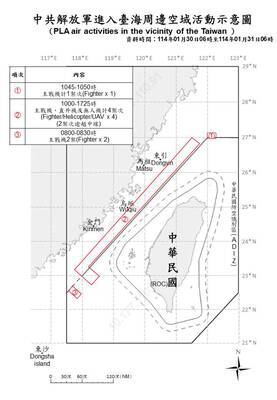South Korean president-elect Yoon Suk-yeol yesterday asked Chinese President Xi Jinping (習近平) for close coordination on North Korea’s complete denuclearization, while Japanese Minister of Foreign Affairs Yoshimasa Hayashi said he had talked with his South Korean counterpart, agreeing to strengthen bilateral cooperation against the North Korean threat both countries are facing.
The moves came after Pyongyang said it test-fired its biggest-yet intercontinental ballistic missile (ICBM) under the orders of North Korean leader Kim Jong-un, who vowed to expand the North’s “nuclear war deterrent” while preparing for a “long-standing confrontation” with the US.
The report by North Korean state media came a day after the militaries of South Korea and Japan said they detected that North Korea had launched an ICBM in its first long-range test since 2017.

Photo: AFP / KCNA VIA KNS
The launch extended a barrage of weapons demonstrations this year that analysts say are aimed at forcing the US to accept North Korea as a nuclear power and remove crippling sanctions against its broken economy, which has been further damaged by COVID-19-related difficulties.
State TV dramatized the testing process like a Hollywood movie, showing Kim walking in slow motion in front of his giant missile in sunglasses and a black leather motorcycle jacket. It edited quick cuts that alternately show Kim and other officials staring at their watches before Kim takes off his shades and nods, with the video then showing the missile being rolled out of the hangar.
The Hwasong-17, which was fired at a high angle to avoid the territorial waters of neighbors, reached a maximum altitude of 6,248km and traveled 1,090km during a 67-minute flight before landing in waters between North Korea and Japan, Pyongyang’s official Korean Central News Agency (KCNA) said.
KCNA said the launch met Kim’s technical objectives and proved the ICBM could be operated quickly during wartime conditions.
The South Korean and Japanese militaries announced similar flight details, which analysts said suggests that the missile could reach targets 15,000km away when fired on a normal trajectory with a warhead weighing less than 1 tonne.
That would place the entire US mainland within striking distance.
Believed to be about 25m long, the Hwasong-17 is North Korea’s longest-range weapon and, by some estimates, the world’s biggest road-mobile ballistic missile system.
North Korea revealed the missile in a military parade in October 2020, and Thursday’s launch was its first full-range test.
KCNA quoted Kim as saying that his new weapon would make the “whole world clearly aware” of North Korea’s bolstered nuclear forces.
He vowed for his military to acquire “formidable military and technical capabilities unperturbed by any military threat and blackmail and keep themselves fully ready for long-standing confrontation with the US imperialists.”
In Seoul, Yoon, who is to take office on May 10, asked Beijing to coordinate closely and work with other countries in the region on North Korea’s denuclearization, Yoon’s office said.
In Tokyo, Hayashi said he talked with South Korean Minister of Foreign Affair Chung Eui-yong by telephone and they agreed to strengthen bilateral cooperation against the North Korean threat and seek further UN Security Council actions against Pyongyang.
US Secretary of Defense Lloyd Austin held separate telephone conversations with his counterparts in South Korea and Japan, in which they discussed response measures to North Korean missile activities and vowed to strengthen defense cooperation, the Pentagon said.
The South Korean Ministry of Unification, which handles inter-Korean affairs, criticized the North for breaking its self-imposed moratorium on ICBM tests.
“Whatever North Korea’s intent may be, the North must immediately suspend actions that create tensions on the Korean Peninsula and destabilizes the regional security situation and return to the table for dialogue and negotiations,” ministry spokesperson Cha Deok-cheol told a news briefing.

Taiwanese actress Barbie Hsu (徐熙媛) has died of pneumonia at the age of 48 while on a trip to Japan, where she contracted influenza during the Lunar New Year holiday, her sister confirmed today through an agent. "Our whole family came to Japan for a trip, and my dearest and most kindhearted sister Barbie Hsu died of influenza-induced pneumonia and unfortunately left us," Hsu's sister and talk show hostess Dee Hsu (徐熙娣) said. "I was grateful to be her sister in this life and that we got to care for and spend time with each other. I will always be grateful to

UNITED: The premier said Trump’s tariff comments provided a great opportunity for the private and public sectors to come together to maintain the nation’s chip advantage The government is considering ways to assist the nation’s semiconductor industry or hosting collaborative projects with the private sector after US President Donald Trump threatened to impose a 100 percent tariff on chips exported to the US, Premier Cho Jung-tai (卓榮泰) said yesterday. Trump on Monday told Republican members of the US Congress about plans to impose sweeping tariffs on semiconductors, steel, aluminum, copper and pharmaceuticals “in the very near future.” “It’s time for the United States to return to the system that made us richer and more powerful than ever before,” Trump said at the Republican Issues Conference in Miami, Florida. “They

GOLDEN OPPORTUNITY: Taiwan must capitalize on the shock waves DeepSeek has sent through US markets to show it is a tech partner of Washington, a researcher said China’s reported breakthrough in artificial intelligence (AI) would prompt the US to seek a stronger alliance with Taiwan and Japan to secure its technological superiority, a Taiwanese researcher said yesterday. The launch of low-cost AI model DeepSeek (深度求索) on Monday sent US tech stocks tumbling, with chipmaker Nvidia Corp losing 16 percent of its value and the NASDAQ falling 612.46 points, or 3.07 percent, to close at 19,341.84 points. On the same day, the Philadelphia Stock Exchange Semiconductor Sector index dropped 488.7 points, or 9.15 percent, to close at 4,853.24 points. The launch of the Chinese chatbot proves that a competitor can

TAIWAN DEFENSE: The initiative would involve integrating various systems in a fast-paced manner through the use of common software to obstruct a Chinese invasion The first tranche of the US Navy’s “Replicator” initiative aimed at obstructing a Chinese invasion of Taiwan would be ready by August, a US Naval Institute (USNI) News report on Tuesday said. The initiative is part of a larger defense strategy for Taiwan, and would involve launching thousands of uncrewed submarines, surface vessels and aerial vehicles around Taiwan to buy the nation and its partners time to assemble a response. The plan was first made public by the Washington Post in June last year, when it cited comments by US Indo-Pacific Commander Admiral Samuel Paparo on the sidelines of the Shangri-La Dialogue